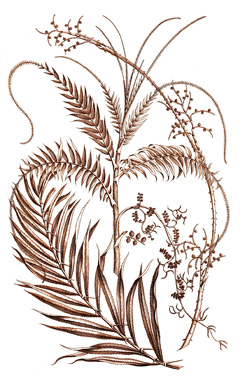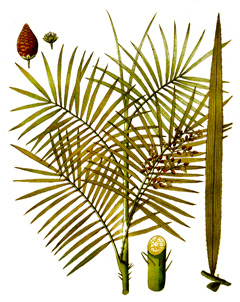 |
|
https://edibleplants.org/ |
 |
| https://edibleplants.org/ |
Translate this page:
Summary
Rattan Cane or Calamus rotang is a dioecious rattan palm that grows up to 10 m tall and 200 m wide. It is native to India, Sri Lanka, and Myanmar but can now be found throughout Southeast Asia. The leaves are pinnate, alternate and with spines on the upper face. The flowers are clustered and enclosed by spiny spathes. Young shoots are cooked and eaten as vegetables. The fruits are edible as well and yield an astringent red resin known as 'Dragon's blood. Dragon's blood is used as a dye, in painting, and in medicine against respiratory and gastrointestinal problems. It is also used as a treatment for wounds, diarrhoea, fever, dysentery, mouth ulcers, and skin conditions. The wood of C. rotang is also used medicinally to expel intestinal worms. The leaves are used for biliousness and blood diseases, and the root for fevers and as an antidote to snake venom. C. rotang yields the best rattan cane among other species. It is split into strips and plaited, used in baskets, chairs, and carriages, made into ropes, etc.
Physical Characteristics

 Calamus rotang is an evergreen Climber growing to 25 m (82ft) by 5 m (16ft) at a fast rate.
Calamus rotang is an evergreen Climber growing to 25 m (82ft) by 5 m (16ft) at a fast rate.
See above for USDA hardiness. It is hardy to UK zone 10 and is frost tender. The plant is not self-fertile.
Suitable for: light (sandy), medium (loamy) and heavy (clay) soils and prefers well-drained soil. Suitable pH: mildly acid, neutral and basic (mildly alkaline) soils. It can grow in semi-shade (light woodland) or no shade. It prefers moist soil.
UK Hardiness Map
US Hardiness Map
Synonyms
Calamus monoecus Roxb. Calamus roxburghii Griff. Draco rotang Crantz Palmijuncus monoecus (Roxb.) Ku
Plant Habitats
Edible Uses
Edible Parts: Fruit Shoots
Edible Uses:
Edible portion: Shoots, Fruit. Young shoots - cooked and eaten as a vegetable[ 317 ]. Fruit - raw[ 2 ]. When ripe the fruit is roundish, as large as a hazelnut and is covered with small, shining scales, laid like shingles, one upon the other. The subacid pulp which surrounds the kernel is sucked out and eaten as a means of quenching the thirst[ 2 ]. Sometimes the fruit is pickled with salt and eaten at tea-time[ 2 ]. The globose fruits are about 13mm in diameter.
References More on Edible Uses
Medicinal Uses
Plants For A Future can not take any responsibility for any adverse effects from the use of plants. Always seek advice from a professional before using a plant medicinally.
Antidote Febrifuge Vermifuge
The wood is vermifuge[ 240 ]. The leaves are used in the treatment of biliousness and diseases of the blood[ 240 ]. The root is used in the treatment of chronic fevers and as an antidote to snake venom[ 240 ].
References More on Medicinal Uses
The Bookshop: Edible Plant Books
Our Latest books on Perennial Plants For Food Forests and Permaculture Gardens in paperback or digital formats.

Edible Tropical Plants
Food Forest Plants for Hotter Conditions: 250+ Plants For Tropical Food Forests & Permaculture Gardens.
More

Edible Temperate Plants
Plants for Your Food Forest: 500 Plants for Temperate Food Forests & Permaculture Gardens.
More

More Books
PFAF have eight books available in paperback and digital formats. Browse the shop for more information.
Shop Now
Other Uses
Basketry Furniture String Weaving Wood
Other uses rating: High (4/5). Other Uses: This is the species which yields the best Rattan Cane of commerce. Other species are, however, used as substitutes. It is split into strips and plaited or woven into baskets, chairs, sofas, and carriages. It is twisted into ropes, or stretched entire across rivers, as the main supports of indigenous suspension bridges[ 387 ]. The core of the cane is made into furniture, basketry etc[ 317 ]. The skin peel is used for weaving of chair seats and bags[ 317 ].
Special Uses
References More on Other Uses
Cultivation details
Most species in this genus are more or less vigorous climbing plants in rainforests. In general, they are likely to grow best with their roots in the shade but with their stems able to grow up to the light. They are also likely to grow best in a humus-rich soil[ K ]. A dioecious species, both male and female forms need to be grown if fruit and seed are required.
References Carbon Farming Information and Carbon Sequestration Information
Temperature Converter
Type a value in the Celsius field to convert the value to Fahrenheit:
Fahrenheit:
The PFAF Bookshop
Plants For A Future have a number of books available in paperback and digital form. Book titles include Edible Plants, Edible Perennials, Edible Trees,Edible Shrubs, Woodland Gardening, and Temperate Food Forest Plants. Our new book is Food Forest Plants For Hotter Conditions (Tropical and Sub-Tropical).
Shop Now
Plant Propagation
Seed
Other Names
If available other names are mentioned here
Rattan Cane or Calamus rotang. Other Names: Bet, Chachi bet, Heart, Pemu, Perambu, Raigong, Tingdon, Vetasa, Vetra, Rattan, Rotang, Rattan Cane
Native Range
TROPICAL ASIA: India (south), Sri Lanka
Weed Potential
Right plant wrong place. We are currently updating this section.
Please note that a plant may be invasive in one area but may not in your area so it's worth checking.
None Known
Conservation Status
IUCN Red List of Threatened Plants Status : This taxon has not yet been assessed.

Growth: S = slow M = medium F = fast. Soil: L = light (sandy) M = medium H = heavy (clay). pH: A = acid N = neutral B = basic (alkaline). Shade: F = full shade S = semi-shade N = no shade. Moisture: D = dry M = Moist We = wet Wa = water.
Now available:
Food Forest Plants for Mediterranean Conditions
350+ Perennial Plants For Mediterranean and Drier Food Forests and Permaculture Gardens.
[Paperback and eBook]
This is the third in Plants For A Future's series of plant guides for food forests tailored to
specific climate zones. Following volumes on temperate and tropical ecosystems, this book focuses
on species suited to Mediterranean conditions—regions with hot, dry summers and cool, wet winters,
often facing the added challenge of climate change.
Read More
Expert comment
Author
L.
Botanical References
Links / References
For a list of references used on this page please go here
A special thanks to Ken Fern for some of the information used on this page.
Readers comment
| Add a comment |
|
If you have important information about this plant that may help other users please add a comment or link below. Only comments or links that are felt to be directly relevant to a plant will be included. If you think a comment/link or information contained on this page is inaccurate or misleading we would welcome your feedback at [email protected]. If you have questions about a plant please use the Forum on this website as we do not have the resources to answer questions ourselves.
* Please note: the comments by website users are not necessarily those held by PFAF and may give misleading or inaccurate information.
To leave a comment please Register or login here All comments need to be approved so will not appear immediately.
|
|